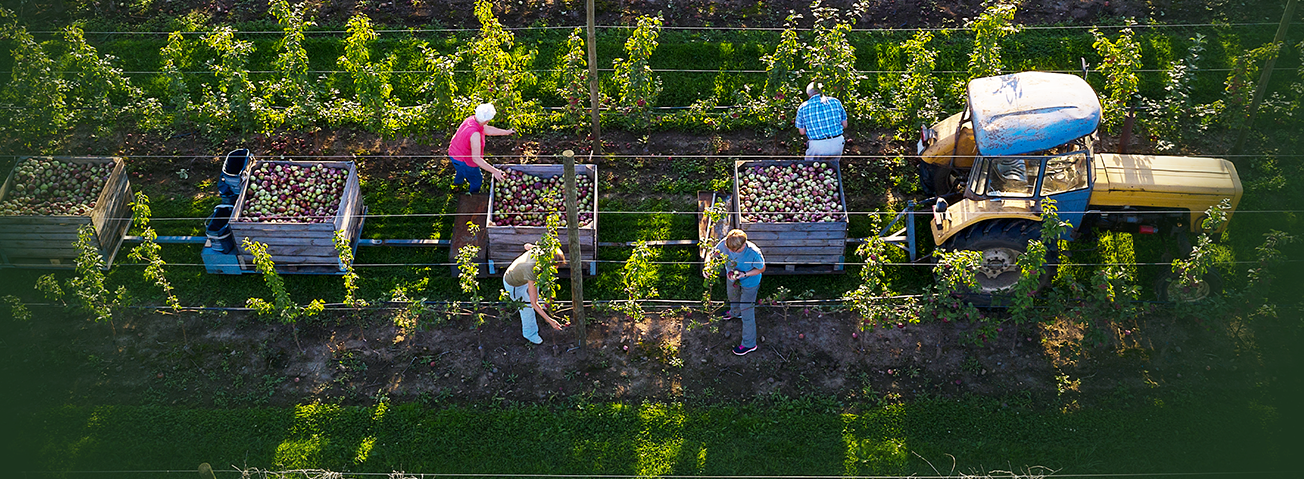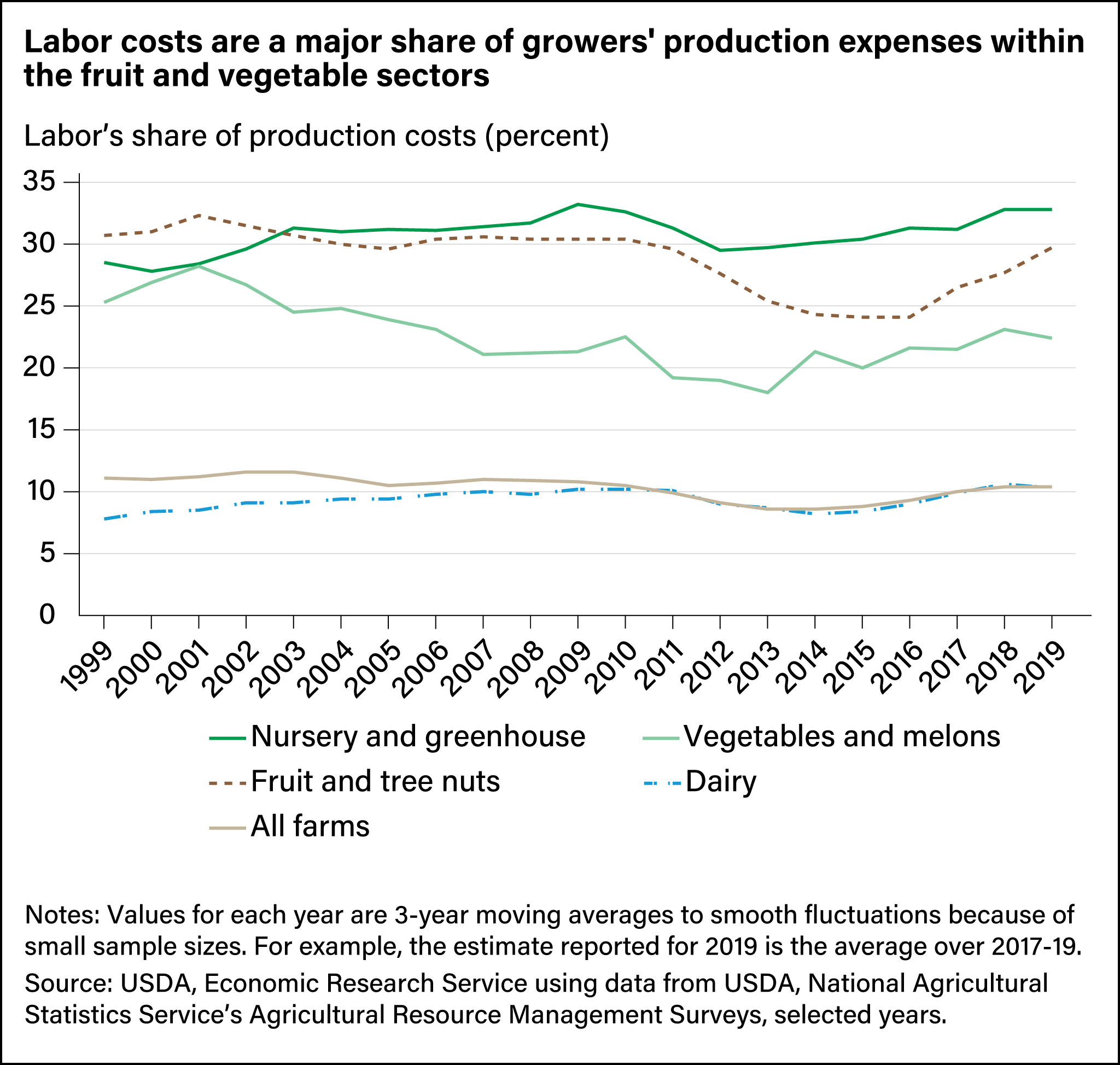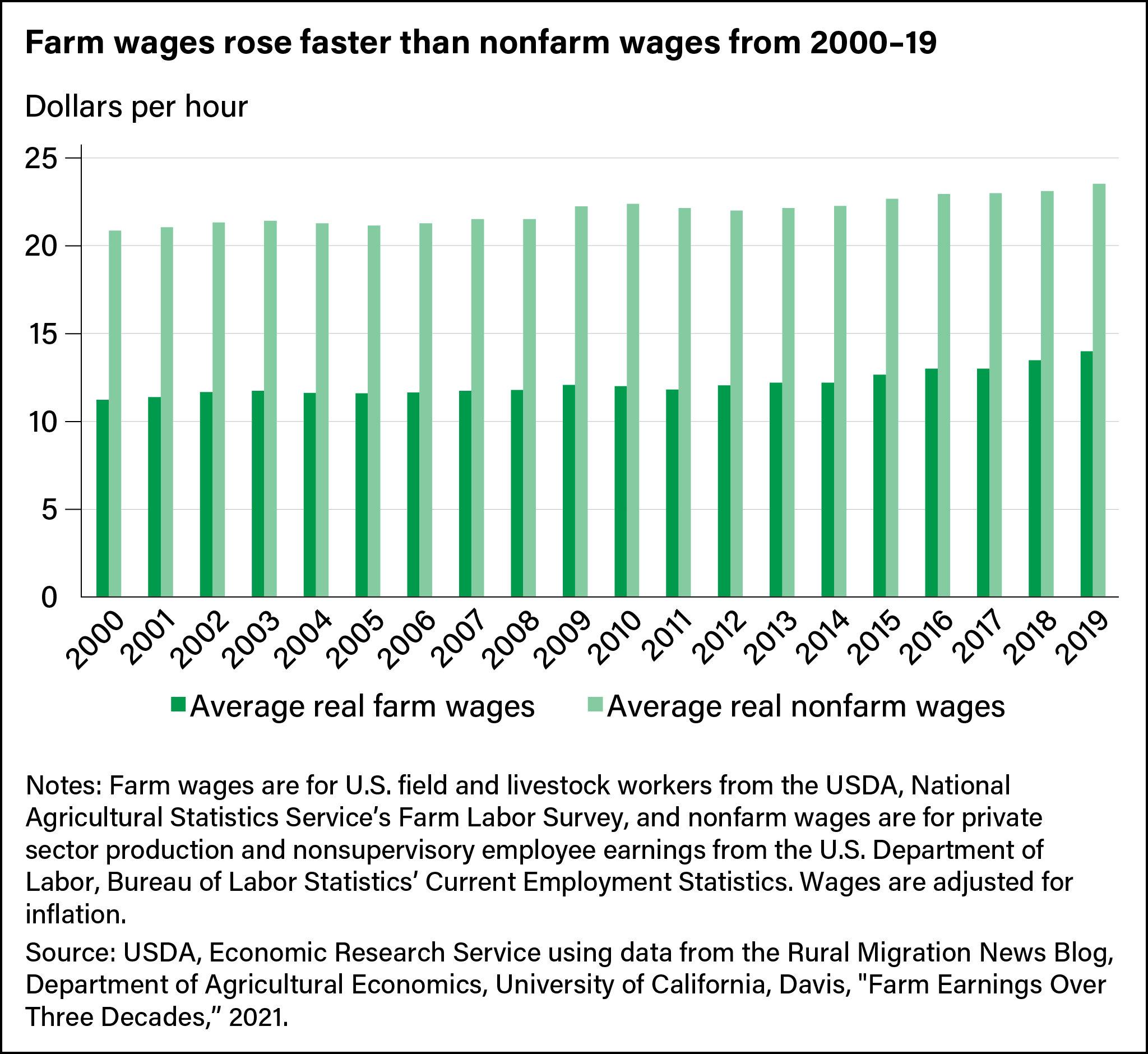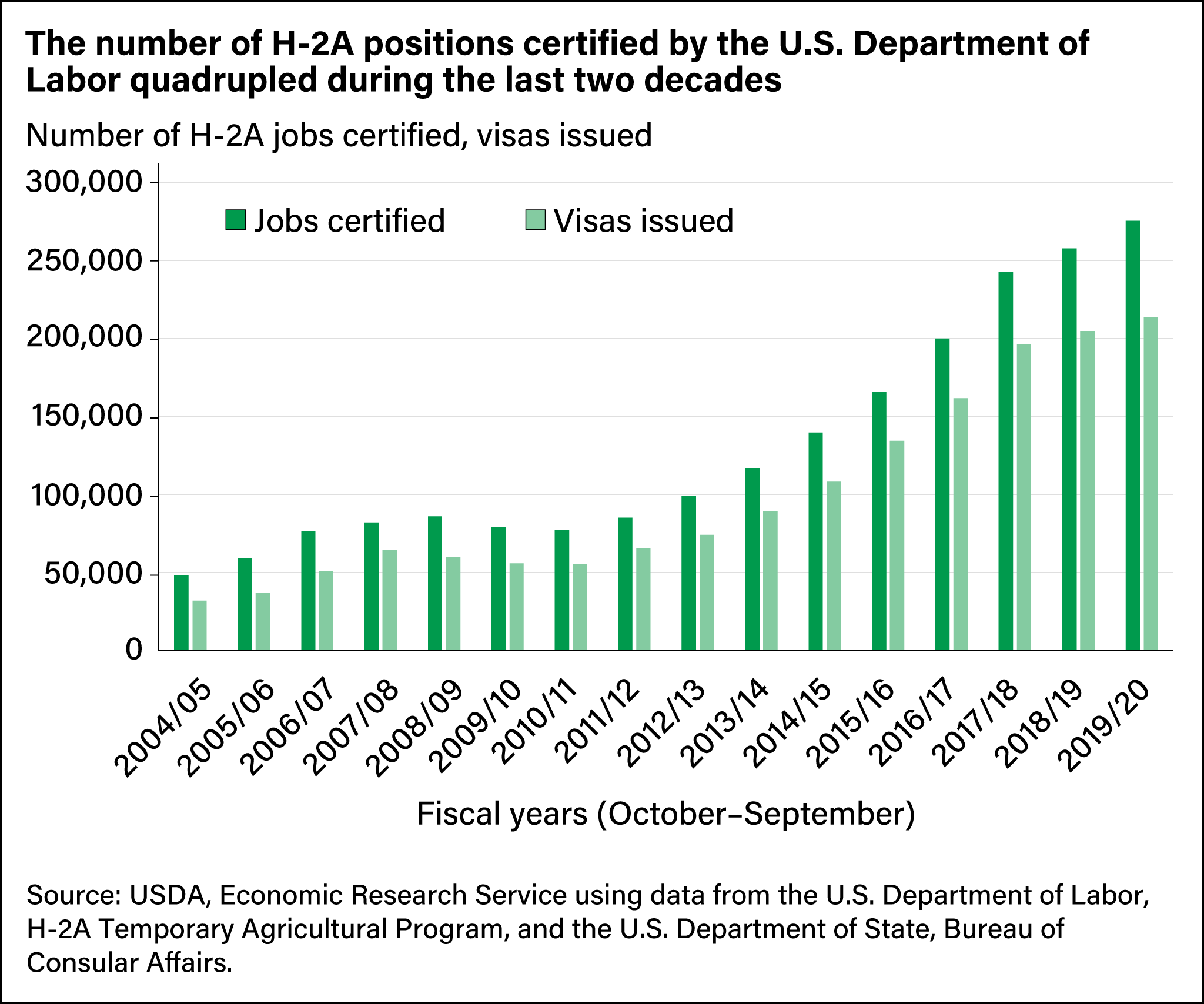
U.S. Fruit and Vegetable Industries Try To Cope With Rising Labor Costs
- by Skyler Simnitt and Philip Martin
- 12/28/2022
Highlights
- Labor is among the biggest expenses U.S. fruit and vegetable growers face, and farm wages are rising at a faster rate than non-farm wages.
- As producers find it more difficult to hire enough workers to meet their labor needs, they are relying more on the H-2A guest worker program for laborers.
- Producers are using machines to increase productivity or to replace workers in some instances.
- Responding to labor shortages, growers are opting to reduce production or switch to crops that require less labor. Marketers of fresh fruit and vegetables are increasing imports, and larger firms are establishing production facilities overseas.
To produce fruits and vegetables in the United States, a human touch is required to sort, pot, and plant seedlings, train young plants and prune older ones, and harvest and pack the crops for shipping. That means hired labor is a critical component of the fruit and vegetable sectors. Labor’s share of the cost of production can run as high as 38 percent for fruit and tree nut farms and 29 percent for vegetables and melons.
Meanwhile, U.S. fruit and vegetable farm operators are having difficulty finding enough workers to fill their needs in a tight labor market, so farm wages are rising at a faster rate than non-farm wages. To address rising labor costs, growers are turning to other production and management strategies to keep their expenses in check. Researchers at USDA’s Economic Research Service, in a recent report, examined how producers are adapting to changing cost structures. They looked at how three adjustments suppliers in these industries are adding to their production and management practices:
- increasing imports and decreasing domestic production of certain crops if they are not competitive with imports,
- increasing the use of mechanical aids, and
- bringing in foreign guest workers through the H-2A visa program.
Farm Worker Wages Are Outpacing Growth in Non-Farm Wages
Average hourly earnings of U.S. field and livestock workers, adjusted for inflation, increased 16 percent between 2001 and 2019. In 2022, minimum wages in 29 States were higher than the Federal minimum wage of $7.25. California and Washington, two major employers of hired agricultural labor, had some of the highest minimum wages at $15.00 an hour and $14.49 an hour, respectively. While empirical evidence of widespread farm labor shortages is limited, agricultural wage growth (16 percent) outpacing that of non-agricultural wages (5 percent growth) suggests farm labor markets are becoming tighter.
Changes to State-specific overtime requirements for agricultural employees are expected to further increase producers’ labor costs. Historically, agricultural employers in most States have been exempt from paying their farmworkers overtime. However, in recent years, some major agricultural States have begun amending their employment statutes for agricultural employers. California (2016), Washington (2021), and Colorado (2022) created statutes to phase in overtime requirements for agricultural employees after a certain number of weekly hours. With the cost of farm labor on the rise, producers of labor-intensive crops have been using three main strategies for coping.
Strategy 1: Increasing Imports and Decreasing Domestic Production of Crops That Are Not Competitive With Imports
The United States is a major producer of fruit and vegetables for both the fresh and processed markets. It is also a major importer of these items. Over the periods spanning 2000–2002 and 2017–19, U.S. production, by volume, of fresh fruit and vegetables changed little, while imports of fresh fruit increased by 129 percent and fresh vegetables by 155 percent. On average, domestic production remained flat between the two time periods, but production of some commodities with higher labor costs such as raisin grapes, melons, iceberg lettuce, and fresh-market field tomatoes declined. The import share of availability—a proxy for consumption—increased to 40 percent from 23 percent for fresh fruits and to 31 percent from 14 percent for fresh vegetables.
Most imported fresh fruit and vegetables come from Mexico and Central or South America. Geographic proximity to the United States, lower labor costs, and trade agreements such as the United States-Mexico-Canada Agreement make Mexico the top supplier for foreign-grown fresh produce. Foreign-grown fruit and vegetables provide U.S. consumers with a steady supply of products year-round as well as access to certain crops such as tropical fruit that are not practical for commercial production in the United States. Depending on the crop and time of year, however, imports can make U.S. producers less competitive. Imports have almost completely displaced U.S. production of pineapples and limes. In another example, some California raisin grape growers have responded to rising labor costs and overseas competition by replacing labor-intensive vineyards with less labor-intensive almond orchards.
Some fresh fruit and vegetable commodities grown in the United States today are more at risk of being displaced by imports than others. For example, Florida growers produce strawberries in the winter/spring, which overlaps with production in Mexico. The same can be said of early season blueberry growers. The U.S. International Trade Commission opened an investigation in 2020 to look into reports from U.S. growers of blueberries in Florida and Georgia that high import volumes of fresh blueberries were causing financial harm to the domestic industry.
The largest U.S. firms also have growing operations abroad and may view strong U.S. demand for their fruits and vegetables as an economic opportunity. By growing the same crops in Mexico, these U.S. producers can supplement their domestic production with imports and fulfill contractual obligations year-round. Bagged-salad processors, for example, sign contracts with domestic buyers to provide specific weekly quantities all year. By establishing farms in Mexico, these growers protect against potential losses from disease and weather events. Similar strategies have been observed among the largest strawberry growers.
Strategy 2: Using Machines To Generate Faster and More Efficient Work During Harvest
Mechanization—the use of machinery to complete tasks previously completed by hand—has a long history in U.S. agriculture. Most field crops are exclusively planted, tended, harvested, and processed by machines. However, it is more difficult to mechanize many tasks in fruit and vegetable farming. Specialty crops are vulnerable to changes in weather, topography, and plant conditions. Many fruits and vegetables are soft, so machines can damage them. Finally, some markets have relatively few producers, which means engineering firms must develop new and expensive technologies for a small market of potential users.
Fruit and vegetable commodities fall along a spectrum varying from easier to harder to mechanize. Commodities that fall along the easier to mechanize end of the spectrum are already largely harvested by machine. Such commodities include tomatoes and blueberries for the processing market, and tart cherries in Michigan. It is easier to mechanize the harvest of these commodities because they are not as likely to be damaged by rough handling, and existing mechanical harvesters work well with existing plant varieties. Along the harder-to-mechanize end of the spectrum are commodities for which few or no viable harvest machines are available such as fresh field tomatoes, iceberg lettuce, and strawberries. For some crops, mechanical aids such as conveyors, hydraulic platforms, and bin-collecting autonomous robots can help workers’ productivity, and full-on mechanical harvesters are now available.
Creating mechanical harvesters requires advanced engineering and extensive trial and error. Breeders and plant scientists must work with engineers to develop plant varieties and technologies that work in concert. Their goals tend to be mutually exclusive, however, as engineers seek efficiency, while growers seek to preserve fruit quality and flavor.
Strategy 3: Employing More Guest Workers Under the H-2A Program
Agricultural employers unable to find sufficient help to meet their labor needs may opt to hire foreign workers under short-term contracts on guest visas known as H-2A. This program provides a necessary labor source for growers to meet their production needs. The H-2A temporary agricultural worker program is administered by three Federal agencies: the U.S. Department of Labor (DOL), the U.S. Department of State, and U.S. Citizenship and Immigration Services. The number of positions certified by the DOL increased fourfold (302 percent) between 2010 and 2021. The H-2A program provides access to higher wages for its participants than what would be available in their country of origin. For instance, more than 90 percent of fruit and vegetable workers are from Mexico, where the minimum wage is typically a tenth of the wage earned by U.S. farm workers.
It generally costs more to employ H-2A workers than it does to hire their domestic (non-H-2A) counterparts. Program rules require the employer to pay a special wage known as the adverse effect wage rate (AEWR), provide housing, and provide transportation from and back to the guest worker’s country of origin. The employer also must cover all fees associated with processing and issuing the visa. The DOL sets the adverse effect wage rate each year for 15 regions and 3 States using data from the USDA’s Farm Labor Survey. The AEWR, which nearly always exceeds the State, Federal, and local prevailing wage rates, is one of the more controversial aspects of the program among employers. Several proposals are pending in Congress to review the administration and necessity of the adverse effect wage rate.
Research shows the share of H-2A workers among all crop workers is increasing. H-2A workers are estimated to make up about 10 percent of the Nation’s crop workers. The top five States in the number of H-2A positions certified are Florida, Washington, North Carolina, Georgia, and California. Although California is among the Nation’s top H-2A employers, California growers request relatively fewer H-2A workers than might be expected given the size of their State’s agricultural sector. Nonetheless, growth in the program has been observed across all States over the last decade, suggesting that despite the higher wage rate and additional costs of employing workers through the program, producers are turning more often to H-2A guest workers for their labor needs.
This article is drawn from:
- Calvin, L., Martin, P. & Simnitt, S. (2022). Adjusting to Higher Labor Costs in Selected U.S. Fresh Fruit and Vegetable Industries. U.S. Department of Agriculture, Economic Research Service. EIB-235.
You may also like:
- Calvin, L., Martin, P. & Simnitt, S. (2022). Supplement to Adjusting to Higher Labor Costs in Selected U.S. Fresh Fruit and Vegetable Industries: Case Studies. U.S. Department of Agriculture, Economic Research Service. AP-103.
- Castillo, M., Simnitt, S., Astill, G. & Minor, T. (2021). Examining the Growth in Seasonal Agricultural H-2A Labor. U.S. Department of Agriculture, Economic Research Service. EIB-226.
- Castillo, M., Martin, P. & Rutledge, Z. (2022). The H-2A Temporary Agricultural Worker Program in 2020. U.S. Department of Agriculture, Economic Research Service. EIB-238.
- Costa, D. & Martin, P. (2020). "Coronavirus and Farmworkers Farm Employment, Safety Issues, and the H-2A Guestworker Program". Economic Policy Institute.




